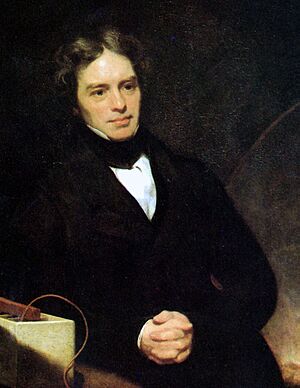Faraday's laws of electrolysis facts for kids
Faraday's laws of electrolysis are important rules in chemistry. They help us understand how much of a substance is made or changed during a process called electrolysis. A famous scientist named Michael Faraday discovered these laws in 1834.
The first law says that the amount (mass) of a substance produced by electrolysis depends directly on how much electricity passes through the cell. This means if you use more electricity, you will get more of the substance.
What is Electrolysis?
Electrolysis is a special way to use electricity to cause a chemical reaction. It happens in a setup called an electrolytic cell. In this cell, electricity passes through a liquid that contains substances dissolved in it. This electricity then breaks down the substances into new ones.
For example, you can use electrolysis to separate water into hydrogen and oxygen gases. It's also used to coat metal objects with a thin layer of another metal, like making a spoon shiny with silver.
Michael Faraday's Discovery
Michael Faraday was a brilliant English scientist. He made many important discoveries in electromagnetism and electrochemistry. In 1834, he carefully studied how electricity affects chemical solutions.
Through his experiments, Faraday noticed a clear pattern. He saw that the amount of a substance created during electrolysis was always connected to the amount of electricity used. This led him to state his famous laws.
Faraday's First Law Explained
Faraday's first law of electrolysis is quite simple to understand. It tells us about the direct relationship between electricity and the amount of substance produced.
- More electricity, more substance: If you send a small amount of electricity through an electrolytic cell, you will get a small amount of the new substance.
- Double the electricity, double the substance: If you double the amount of electricity, you will get twice as much of the substance.
- Half the electricity, half the substance: If you use half the electricity, you will get half the substance.
This law is very useful for scientists and engineers. It helps them predict how much of a chemical they can make using a certain amount of electricity. It's like a recipe where the amount of ingredients depends on how much you want to bake!
See also
 In Spanish: Leyes de Faraday de la electrólisis para niños
In Spanish: Leyes de Faraday de la electrólisis para niños


